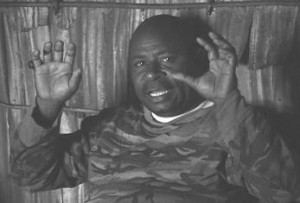 Late in 2006, Pastor Jacob Kepas (a Baptist minister) was interviewed by Paul Nation, in a hut in Tawa Village, deep in the mountainous interior of the mainland of Papua New Guinea. Kepas had recently climbed up a hill adjacent to a cliff where some of the nocturnal flying creatures sleep during the day. He was accompanied by a local villager who confirmed that what was on that cliff was indeed an indava, the creature that glows at night.
Late in 2006, Pastor Jacob Kepas (a Baptist minister) was interviewed by Paul Nation, in a hut in Tawa Village, deep in the mountainous interior of the mainland of Papua New Guinea. Kepas had recently climbed up a hill adjacent to a cliff where some of the nocturnal flying creatures sleep during the day. He was accompanied by a local villager who confirmed that what was on that cliff was indeed an indava, the creature that glows at night.
During the videotaped interview, Kepas and his guide described how they had observed the sleeping winged creature. They had tried to videotape it from the hill they had climbed, but the resulting footage was poor, perhaps from a combination of inexperience of the camera operators and the distance involved (Kepas was observing it through binoculars). But even with binoculars, Kepas had been uncertain that it was the creature that they sought until his guide climbed up higher for a better view, confirming that it was an indava.
But that was not the first time that Kepas had observed a strange flying creature. When he was a boy, in another area of the mainland of Papua New Guinea, he had seen a seklo-bali as the glowing creature had flown overhead. Researchers believe that the seklo-bali, ropen, and indava may be closely related or even the same species of bioluminescent flying creature, apparently living pterosaurs.
Regarding the objectiveness of Kepas, in his 2006 sighting of what was identified as an indava, consider this: Kepas himself voiced his uncertainty that what he was observing was the creature that they had sought; the distance and viewing angle made identification difficult. After the other man had climbed higher, obtaining a better viewing angle, it was confirmed to be an indava. This confirms that Kepas is capable of objectiveness in his observations, for he did not force a conclusion when the conditions were inadequate for certainty.
In this 2006 expedition, Nation and Kepas were flown into the remote mountainous area by missionary pilot Jim Blume, who has been a great help, for many years, in living-pterosaur investigations.
See also “Fight With a Kor in Northern Papua New Guinea”
This Baptist minister has worked with the Baptist missionary James Blume, in assisting American ropen searchers and in helping the living-pterosaur investigations in general.


